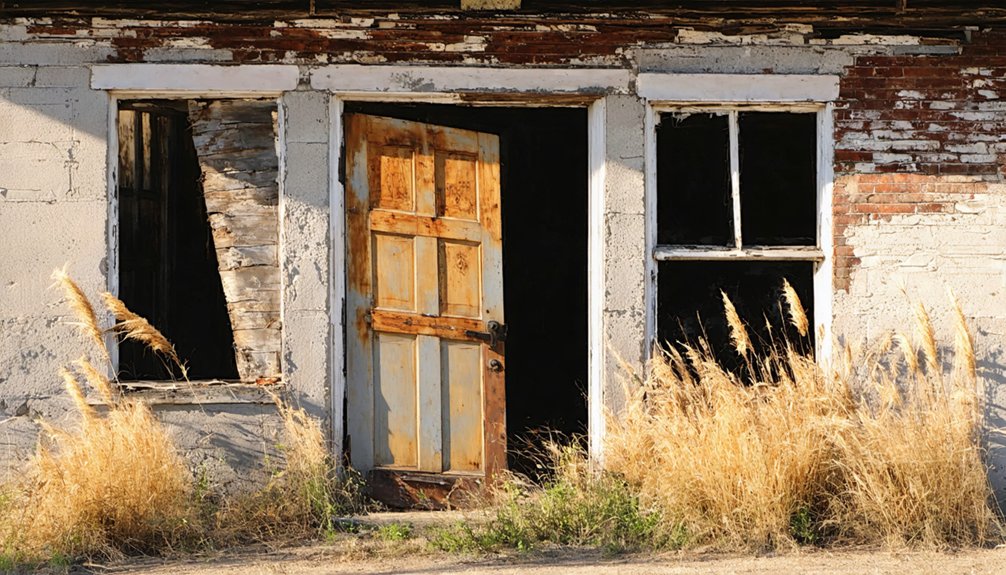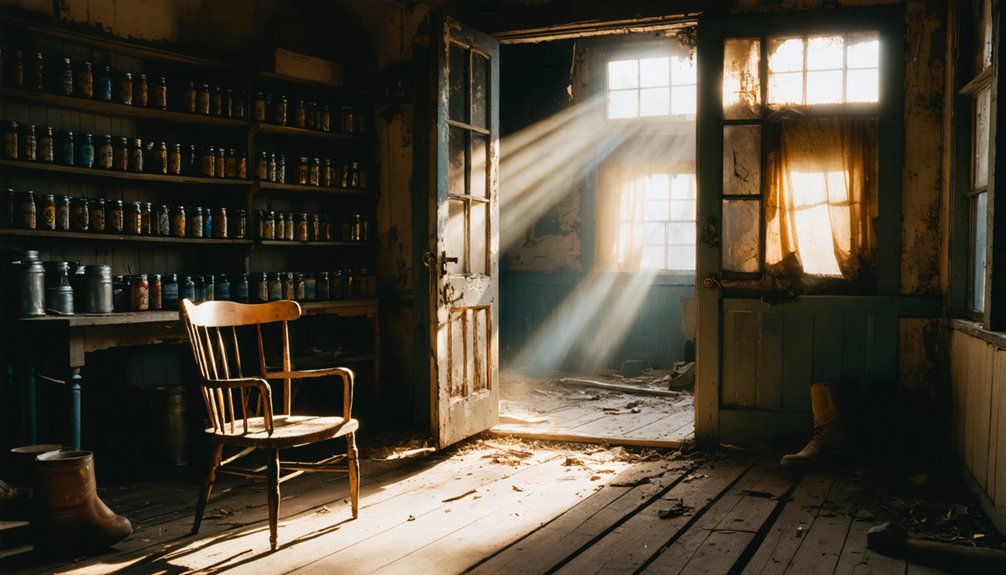You’ll find Hart Camp‘s haunting remains at the crossroads of Farm Roads 37 and 168, about 17 miles northeast of Littlefield in Lamb County, Texas. This former cotton farming community, established in the late 1920s by R.C. Hopping, once boasted a school, cotton gin, and two stores before declining in the 1960s. Today, weathered structures and scattered ruins tell tales of pioneer spirit and agricultural dreams, beckoning those who seek authentic glimpses of Texas’ forgotten past.
Key Takeaways
- Hart Camp is a ghost town located 17 miles northeast of Littlefield in Lamb County, Texas, at Farm Roads 37 and 168.
- Founded by R.C. Hopping in the late 1920s, it flourished as a cotton farming community with stores, a cotton gin, and school.
- The town experienced decline in the 1960s as families left, transforming from a thriving agricultural community into a ghost town.
- Notable ruins include the abandoned school building, cotton gin remains, and scattered foundations of former homes and businesses.
- Visitors must navigate unpaved roads and obtain proper permissions, as the site may be on private property with limited accessibility.
Early Origins and Settlement
When R.C. Hopping staked his claim in the Texas Panhandle during the late 1920s, he wasn’t just buying land – he was laying the community foundation for what would become Hart Camp.
You’ll find that this settlement emerged as a representation of agricultural development in the region, quickly establishing itself with essential facilities that defined frontier life.
If you’d visited Hart Camp in its early days, you’d have discovered a bustling farmer’s store, a cotton gin, and a school that served as the beating heart of this rural outpost.
Much like the tragic Camp Scott in Oklahoma, Hart Camp’s early history was marked by isolation and the challenges of frontier living.
While the exact story behind the town’s name remains a mystery, the purpose was clear: create a self-sustaining community that could support local farmers and ranchers.
It’s a classic tale of Texas entrepreneurship, where speculation met opportunity in the vast Panhandle plains.
Decades later, the abandoned school building stands as one of the few remaining structures, a silent testament to the town’s bygone era.
Location and Geographic Features
Standing amid the vast Texas Panhandle plains, Hart Camp’s strategic location at the crossroads of Farm Roads 37 and 168 made it a natural gathering point for early settlers.
You’ll find this ghost town geography shaped by its position 17 miles northeast of Littlefield, nestled between Spade and Olton in Lamb County. Historical topographic maps reveal this strategic placement made it an ideal spot for community development. The 1954 Clovis map provides the earliest detailed documentation of Hart Camp’s layout and surroundings.
The terrain tells a story of resilience in the Texas Panhandle’s challenging environment:
- Semi-arid climate with hot summers and cold winters, perfect for the adventurous spirit
- Rich soil near Blackwater Draw that supported cotton farming and ranching
- Wide-open spaces with sparse grassland and scrub, offering unlimited horizons
Today, while the winds still sweep across these plains, you’ll discover a landscape that’s remained largely unchanged, preserving the raw beauty that first drew pioneers to this corner of Texas.
From Trading Post to Ghost Town
Unlike traditional frontier trading posts that dotted the Red River, Hart Camp emerged in the late 1920s as R.C. Hopping’s bold venture into Texas’s agricultural frontier.
You’ll find no ancient trading patterns here – this was purely a cotton farming community that quickly sprouted a school, gin, and two stores by 1930.
While it flourished briefly as a bustling farm town, Hart Camp couldn’t escape the brutal reality of rural decline that swept through America’s heartland.
John Hart, who became the first sheriff of Fannin County, established early settlements in this region decades before Hart Camp existed.
The area’s earlier history included the establishment of trading posts nearby by Holland Coffee in the 1830s.
By the 1960s, the school bells fell silent as families drifted away. The once-proud buildings that housed dreams of agricultural prosperity now stand in various states of decay.
What you’ll see today is a ghost town where empty streets and deteriorating structures tell the story of a community that rose and fell with the rhythms of 20th-century farming life.
Notable Historical Events
Although Hart Camp’s historical record remains sparse, several crucial moments shaped this agricultural town‘s brief existence.
Similar to Terlingua’s mining boom, Hart Camp experienced a period of economic prosperity driven by local agriculture, though on a much smaller scale. Like many no longer existing communities across Texas, you’ll find the historical significance of this West Texas settlement reflected in the community memories passed down through generations, marking key turning points that defined its destiny.
- R.C. Hopping’s bold establishment of the town in 1927 sparked a brief but vibrant period of growth, with essential businesses and services quickly taking root.
- The development of the cotton gin and school in 1930 transformed Hart Camp into a self-sustaining agricultural hub, creating a sense of permanence and prosperity.
- The school’s closure in the 1960s dealt the final blow to the town’s liveliness, marking the end of an era and accelerating its shift to ghost town status.
Architectural Remains and Ruins
In Hart Camp today, you’ll find only a handful of weather-beaten structures that tell the story of this once-thriving agricultural community. The old school building stands as the most prominent reminder of bygone days, while the former gin building and its scale house showcase the town’s cotton farming heritage. The ruins are similar to the Lower Ghost Camp site in San Angelo State Park, where nature steadily reclaims abandoned human structures.
You can still spot the farmer’s store, though time hasn’t been kind to these wooden landmarks. Like many Texas ghost towns that suffered from economic shifts, the buildings here reflect the harsh realities of changing times.
Unlike other ghost towns that boast elaborate architectural styles or stone ruins, Hart Camp’s remaining buildings reflect the simple, practical design of early 1900s rural Texas. The preservation challenges are evident – most original structures have succumbed to decades of neglect, leaving only foundations and partial walls as silent witnesses.
The surviving buildings, though deteriorating, offer a genuine glimpse into life in a small Texas Panhandle farming community.
Exploring Hart Camp Today
You’ll find Hart Camp’s remaining structures scattered across the Texas Panhandle landscape, including the dilapidated school building, Foster’s grocery store, and a cotton gin with its scale house.
While most original buildings have succumbed to time and demolition, you can still trace the town’s footprint through these surviving landmarks.
Getting to Hart Camp requires traversing rural roads through Lamb County, where you’ll want to bring plenty of water and a reliable map since there’s little signage to guide your exploration.
Remaining Structures and Ruins
Today’s visitors to Hart Camp will find themselves wandering among the haunting remains of what was once a bustling Texas settlement. As a neglected ghost town, the remaining structures tell stories of abandonment through their weathered wooden frames and collapsed roofs.
Nature’s reclaimed her territory here, with vegetation creeping through foundations and around the scattered ruins of homes and community buildings.
You’ll discover these evocative remnants throughout the site:
- Roofless wooden houses and the skeletal frames of former residences
- Foundations of a general store and community hall, barely visible through encroaching brush
- Rustic artifacts like old well parts, scattered glass fragments, and rusted hardware from daily life
The site’s untamed state offers urban explorers and photographers raw, authentic glimpses into Texas’s forgotten past.
Accessing The Ghost Town
Reaching Hart Camp requires careful planning and a spirit of adventure, as this remote ghost town isn’t your typical tourist destination.
You’ll need to navigate rural, often unpaved roads in Lamb County, so bring along GPS coordinates and historical maps to guide your journey. Since there’s no visitor center or maintained parking, you’re truly exploring off the beaten path.
Before heading out, remember these essential navigation tips: download offline maps, pack plenty of water, and inform someone of your plans.
Safety precautions are vital – cell service is spotty, and emergency help isn’t readily available. You’ll also want to check land ownership and secure necessary permissions, as the site may be on private property.
With nine historic maps available, you can plot your course through this fascinating piece of Texas history.
Legacy in Texas Panhandle History

As a tribute to the rise and fall of agricultural communities in West Texas, Hart Camp stands as a powerful reminder of how economic shifts transformed the Texas Panhandle’s landscape during the 20th century.
You’ll find this ghost town‘s story deeply woven into the region’s agricultural trends and community dynamics, reflecting a broader pattern of boom-and-bust cycles that shaped rural Texas.
Hart Camp’s legacy lives on through:
These weathered remains of Hart Camp echo the dreams and determination of those who carved out life in Texas’ unforgiving plains.
- Its cotton gin ruins, showcasing the area’s once-thriving cotton economy
- The abandoned school building, representing the tight-knit community that called this place home
- The remaining structures that tell the tale of speculative development and agricultural innovation
You’re witnessing more than just abandoned buildings – you’re seeing the fingerprints of bold pioneers who dared to build communities in the vast Texas frontier.
Frequently Asked Questions
What Dangerous Wildlife Might Visitors Encounter at Hart Camp Today?
You’ll need to watch for rattlesnakes, cottonmouths, and coyotes while exploring. Snake sightings are common, and insect hazards like scorpions, black widows, and disease-carrying ticks pose serious risks.
Are Metal Detectors Allowed When Exploring the Hart Camp Site?
You’ll need proper permits and landowner permission before metal detecting at the site. Due to strict regulations protecting historical artifacts, you can’t just show up and start searching.
What Is the Best Time of Year to Visit Hart Camp?
You’ll find the best season is spring (March-May) or fall (September-November), when weather conditions are mild and comfortable. You’re free to explore longer with perfect temperatures and beautiful scenery.
Does Hart Camp Require Special Permits or Permissions to Visit?
You don’t need special permits to visit! The site’s visitation rules are pretty relaxed since it’s at a public road intersection. Just follow basic exploration guidelines and respect any structures you encounter.
Has Any Paranormal Activity Been Reported at Hart Camp?
While Texas has plenty of haunted locations, you won’t find documented ghost sightings at Hart Camp. That doesn’t mean there’s nothing spooky there – many abandoned towns hold secrets that haven’t been reported yet.
References
- https://www.youtube.com/watch?v=SSvUkUi3g3k
- https://www.redriverhistorian.com/post/the-drowned-town-of-preston-aka-coffee-s-trading-post
- https://pastmaps.com/explore/us/texas/lamb-county/hart-camp/hiking-exploration
- https://en.wikipedia.org/wiki/List_of_ghost_towns_in_Texas
- https://www.texasescapes.com/TexasPanhandleTowns/Hart-Camp-Texas.htm
- https://www.texasescapes.com/TOWNS/Texas-Ghost-Towns-5-Texas-Panhandle.htm
- https://www.onlyinyourstate.com/experiences/oklahoma/haunted-camp-scott-ok
- https://dfwurbanwildlife.com/2019/02/26/chris-jacksons-dfw-urban-wildlife/the-wise-county-time-machine/
- https://www.tshaonline.org/handbook/entries/hart-tx
- https://pastmaps.com/explore/us/texas/lamb-county/hart-camp/metal-detecting



